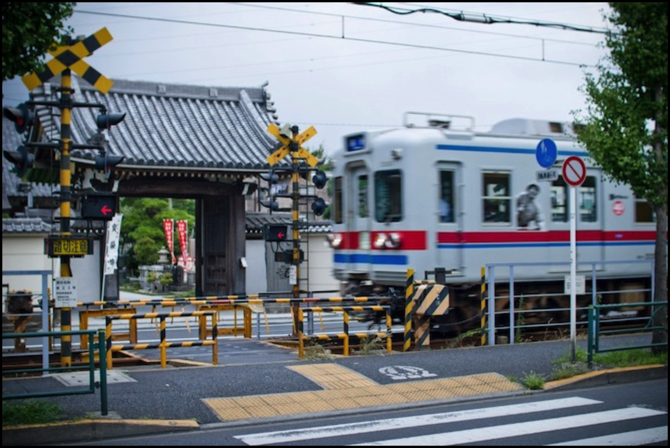The Smaller Railroads of Tōkyō
20 August 2011 00:38 Filed in: Prototype

Railroading in Tōkyō isn’t just huge railway stations and double-track commuter lines bringing people into the city from hours away, there are a number of much smaller railways, serving neighborhoods, industrial areas, or what have you. The photo above (from flickr, photographer: haribote) shows one of these, the Keisei-Kanamachi Line, (see also Japanese wikipedia) a mostly single-track line running 2.5 km through a residential neighborhood of Katsushika City, one of Tōkyō’s 23 special wards (which formed the original city of Tōkyō). The line runs due north from where it meets the Keisei Main Line at Keisei-Takasago station. The last station is adjacent to JR East’s Kanamachi Station on the Jōban Line.
The Keisei-Kanamachi Line would make for an interesting model, albeit perhaps a bit limited in scope. It has just three stations, and is double track for the first two, dropping to single track just past the second station. Along the way it passes both a wooded shrine (Shibamata-Hachiman Jinja Shine, dedicated to Hachiman the Shinto god of archery and war, google maps) and a temple with associated cemetery (Ryokan-Ji Temple, dedicated to Hotei, the Buddist god of contentment and happiness, google maps). The photo above shows a train passing the entrance to Ryokan-Ji Temple.
Like other Keisei Railway lines, the track is Standard Gauge (1435mm) rather than the more common narrow gauge. Power is 1500 V DC from overhead wire. Trains on the line are four-car sets of 3300 (Japanese) and 3500 Series (Japanese) equipment, and operate on 10 minute headways morning and evening, and 15-minute headways during the day.
The one difficulty with modeling these kinds of lines would be the absence of any models of the actual train used. They’re not exactly big draws for the Japanese market. Micro Ace made a model of the now-discontinued Keisei 3200 series (which looks a lot like the train in the photo above, it could be either a 3300 or 3200) about five years ago, but it’s likely very difficult to find. Greenmax makes a kit form of the 3500, if you’re really a serious modeler. I’m not sure either is exactly the version used on this line, but they’d probably be “close enough”.
Tōkyō also has a number of waterfront lines. Okay, these are really in Kawasaki, part of the Tōkyō Metropolitan Area, but not one of the 23 wards making up Tōkyō itself, in fact it is in a different prefecture immediately south of Tōkyō. One example: the freight-only lines of the Kanagawa Rinkai Railway (Rinkai means “waterfront”). Three of these lines radiate out from the Kawasaki Freight Terminal on the Tōkaidō Freight Line to serve port facilities on nearby artificial islands (google maps). These are all freight-only, diesel-served lines, mainly hauling oil tanks (one of the three serves no industries, and is apparently only used for training now, according to Japanese wikipedia). I don’t think anyone makes models of the KRR’s diesels, although Kato once made a Keiyo Rinkai Railway KD55 that looks similar to the DD60 used on the KRR.
But just south of these is JR East’s Tsurumi Line, a 7 km line with two additional branches of 1.6 and 1.7 km each. This is a typical electrified narrow gauge (1067mm) line with multiple passenger stations, except that it serves an industrial port area that is also busy with freight (again, most freight here is oil in tank cars). Trains on the line are three-car 205 series sets and while much of the track is double track, the stations are all single side-platform arrangements. Train frequencies vary, up to as long as two hours between trains at some stations during the day (the primary passengers are apparently workers going to and from the oil terminals and port facilities, mainly at shift change). While much of the traffic here is also oil, past the end of passenger service at Ōgimachi station can be seen a string of hopper cars, serving what appears to be a coal dock (google maps). Kato once made a Tsurumi 205-series set, but it’s long sold out.
Tōkyō railroading isn’t just commuter trains.




